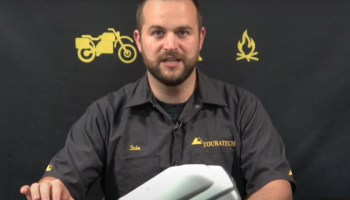This is part 3 of our 3 part series focusing on the BMW R1250GS.
This episode explains the changes and improvements to the Chassis!
The addition of the new member of the GS family to the ADV landscape is very exciting and Touratech is at the forefront with a full range of parts and adventure experts with the knowledge to take your ride to the max!
There is a full transcript of this video below:
Let’s talk about the changes that BMW made in the body and the chassis of the R1250GS. BMW claims they’ve spent more time in the wind tunnel, so hopefully they’ve improved the air flow over the rider while you’re going down the highway. I’m not a very big guy. I personally thought that the previous bike was really good riding down the highway. Hopefully this one’s even better as far as air management is concerned.
The wheel base of the R1250GS has been increased 18 mm from the wheel base of the R1200GS. This is something that BMW didn’t really call out in their press release but I noticed it going through the specifications of the bike. I’m not really sure what to think about that. One of my favorite things about the R1200GS was how short and how nimble it was at low speeds. I think 18 mm increase, which is a little less than an inch, probably isn’t going to make a huge difference there. But maybe it’ll increase a little bit of the bike’s stability when you’re riding on loose terrain, off road or even going down the highway. That’ll be interesting to see once we get our chance to ride one.
The next generation dynamic ESA system is now standard on the R1250GS. If you want to learn more about how that system works, watch the video about the electronic system on the motorcycle. But the reason it’s important for the chassis of the bike is it has an auto leveling feature now where when you add weight or a passenger onto the motorcycle, the suspension will automatically level the ride height of the motorcycle and that keeps your chassis more balanced. It’ll make your bike handle better in all sorts of different terrains if the chassis is level and all the angles are where they’re supposed to be. That’s a good feature.
Talking about suspension, many of you will be familiar with the R1200GS Rally. That was available in the 2017, 2018 model years and that is a new thing for BMW that it was available with what they called sports suspension. What that was, was they essentially took the shocks off of the R1200GS Adventure and put them on a standard GS. That sport suspension package looks like it’s now optional on all models of the R1200GS. If you want your bike to be a little bit taller and have a little bit stiffer springs on it, then that sport suspension option is what you’re going to be looking for.
the R1250GS looks like it’s gained about 23 pounds according to BMW’s paperwork. That’s kind of a big number but considering the increase in horsepower and torque, my guess is you won’t really notice the weight until the thing’s on its side and you’re trying to pick it up again.
The fuel capacity has not changed on the motorcycle. The good news is with that four percent decrease in fuel consumption, the range has increased slightly. It’ll be interesting to see real world what the differences are in range between those two motorcycles. I’m sure as soon as we get our hands on a bike, we’re going to go do a comparison test between the previous generation and the current one. We’ll be sure to report back on that.
Lastly, the seat height of the motorcycle has not changed. If you fit onto the standard height, the Adventure height or a lowered version of the R1200GS. You’ll fit just exactly the same on the same versions of the R1250GS.
If you want to learn more about the bike or the full line or products that Touratech’s developing for it, visit our website, Touratech-USA.com.
